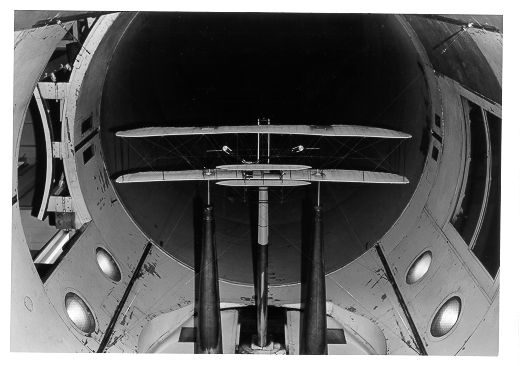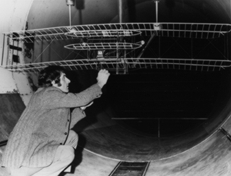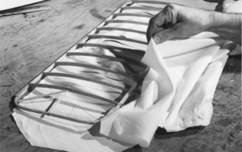My Involvement in the AIAA Wright 'Flyer' Project
By Dr. Fred Culick, Project Chief Engineer


The model was tested in the large Cal Tech wind tunnel in December 1980.
|
One Saturday in the winter of 1977, I took a youth ice hockey team to San
Diego to play two games, one in the morning and one in the late afternoon.
(I was the coach; I also played with the Caltech ice hockey team until I
broke my left leg in 1983.) Between those two games I had a lot of time
so I visited the Aerospace Museum in Balboa Park, mainly to see
Lindbergh's "Spirit of St. Louis." There was also a full-size copy of the
1903 Wright 'Flyer,' built by the Los Angeles AIAA Section in 1953. When
I saw the aircraft, a little strange-looking because it has the horizontal
tail in front (the 'canard'), I suddenly realized that I did not know why
the airplane had that unusual shape. It's an interesting question: why
did the Wrights put the tail in front? We know just by looking around
that almost all aircraft have tails in the rear! A little later, in the
museum bookshop, I bought a wonderful book called "Aeronautics from 1799
to 1909" written by Charles Gibbs-Smith, an English historian, whom I
later came to know well. That experience began my interest--and a lot of
work--in aeronautical history.

The wing span is about seven feet.
|
Sometime later I had the idea that it would be fun--perhaps even
interesting to others--to build and test a model of the 1903 'Flyer.' I
was able to obtain a little financial support from NASA to help pay for
the model and the wind tunnel tests. So I designed and constructed the
1/6 scale model shown in the accompanying photographs.
The model now hangs in our living room at home in Altadena.
Before I had finished my little project with the 'Flyer' model, I read a
notice in the newsletter of the Los Angeles AIAA Section. It announced
that the 'Flyer' I had seen in San Diego had been destroyed in a fire.
The AIAA received $20,000 from the insurance. Howard Marx, who at that
time had responsibility for the money in the AIAA, decided that they
should construct a flying copy of the airplane. With his announcement
that I had read, he was seeking volunteers to help. I answered.
 You can judge the model scale from the size of my hands. The model is 1/6th scale.
You can judge the model scale from the size of my hands. The model is 1/6th scale.
|
It happened that I was the first to respond to Howard's call for help.
One night we met in Los Angeles for dinner to discuss the possibilities.
I described to Howard my plan for carrying out wind tunnel tests and
obtaining the first data about the flight characteristics of the 1903
'Flyer.' We knew that would be useful information for building a piloted
version. Why? Because we could then make small changes in the design to
give us an aircraft safer to fly. The original airplane was difficult and
dangerous to fly--very unstable. So Howard immediately accepted my offer
to make my test results available to the project--but in return, I wanted
to be the first pilot. He agreed, but said I would also have to do some
work and he appointed me Chief Engineer. (He was the first Chairman of
the AIAA Wright 'Flyer' Project). That's how the project began over
dinner one night in Los Angeles in 1979!
In late December 1980 I tested the model at Caltech, with the help of
several others who knew better than I how to run the large wind tunnel.
The results were published in a report. Another group associated with the
AIAA Wright 'Flyer' project built and tested a 1/8 scale model of the
'Flyer.' With all of these data we already knew a lot about how the
airplane should fly--but not everything.
Sometime after the project started--and we quickly attracted many
volunteers--we received a proposal from people at the NASA Ames Research
Laboratory to test our full-size airplane in their large, low-speed wind
tunnel. We accepted the offer and decided to build two aircraft: one to
test in the Ames tunnel, and one later to fly on or before the anniversary
in December 2003.
Copyright © 1999-2002, AIAA Wright Flyer Project,
all rights reserved.




 You can judge the model scale from the size of my hands. The model is 1/6th scale.
You can judge the model scale from the size of my hands. The model is 1/6th scale.